List of obelisks in Rome

The city of Rome harbours the most obelisks in the world. There are eight ancient Egyptian and five ancient Roman obelisks in Rome, together with a number of more modern obelisks; there was also until 2005 an ancient Ethiopian obelisk in Rome.
The Romans used special heavy cargo carriers called obelisk ships to transport the monuments down the Nile to Alexandria and from there across the Mediterranean Sea to Rome. On site, large Roman cranes were employed to erect the monoliths.
Ancient Egyptian obelisks
At least eight obelisks created in antiquity by the Egyptians were taken from Egypt after the Roman conquest and brought to Rome.
| Image | Height (with base) |
Name | Builder | Location | Notes |
|---|---|---|---|---|---|
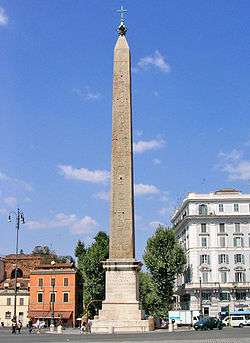 |
32.18 m (45.70 m) |
Lateranense | Tuthmosis III / Tuthmosis IV | Piazza di San Giovanni in Laterano 41°53′12.6″N 12°30′17.2″E / 41.886833°N 12.504778°E |
Tallest obelisk in Rome, and the largest standing ancient Egyptian obelisk in the world, originally weighing around 455 tons.[1] From the temple of Amun in Karnak,map and brought to Alexandria with another obelisk by Constantius II, and brought on its own from there to Rome in 357 to decorate the spina of the Circus Maximus.map Found in three pieces in 1587, restored approximately 4 m shorter by Pope Sixtus V, and erected near the Lateran Palace and basilica of San Giovanni in Laterano in 1588 in the place of the equestrian statue of Marcus Aurelius, which was moved to the Capitoline Hill. Current version weighs around 330 tons.[2] |
 |
25.5 m (41 m)[A 1] |
Vaticano | Unknown | Saint Peter's Square 41°54′8.1″N 12°27′26.1″E / 41.902250°N 12.457250°E |
 The old Basilica of Saint Peter with the obelisk at the left in its original place. |
 |
24 m (36.50 m) |
Flaminio | Seti I / Ramses II | Piazza del Popolo 41°54′38.6″N 12°28′34.8″E / 41.910722°N 12.476333°E |
Originally from Heliopolis.map Brought to Rome by Augustus in 10 BC with the Solare obelisk and erected on the spina of the Circus Maximus.map Found with the Lateranense obelisk in 1587 in two pieces and erected by Pope Sixtus V in 1589. Sculptures with lion fountains were added to the base in 1818. Weighs around 235 tons.[2] |
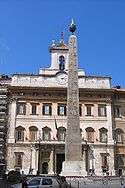 |
21.79 m (33.97 m) |
Solare | Psammetichus II | Piazza di Montecitorio 41°54′2.5″N 12°28′43.2″E / 41.900694°N 12.478667°E |
Originally from Heliopolis.map Brought to Rome by Augustus in 10 BC with the Flaminio obelisk to form the gnomon of a sundial on the Campus Martius.map Found in the 16th century but reburied. Rediscovered and erected by Pope Pius VI in front of the Palazzo Montecitorio in 1792. |
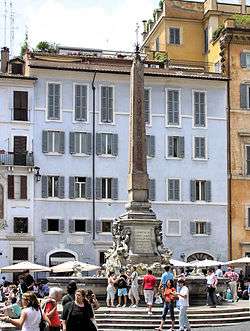 |
6.34 m (14.52 m) |
Macuteo | Ramses II | Piazza della Rotonda 41°53′57.6″N 12°28′36.3″E / 41.899333°N 12.476750°E |
Originally one of a pair at the Temple of Ra in Heliopolis, the other being the now much shorter Matteiano. Moved to the Temple of Isis near Santa Maria sopra Minerva. Found in 1373 near San Macuto and erected in Piazza Macuta. Moved to the front of the Pantheon by Pope Clement XI in 1711 over a fountain by Filippo Barigioni. |
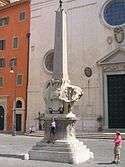 |
5.47 m (12.69 m) |
Minerveo | Apries | Santa Maria sopra Minerva 41°53′52.7″N 12°28′39.2″E / 41.897972°N 12.477556°E |
Originally one of a pair from Sais. Brought to Rome by Diocletian for the nearby Temple of Isis. Found in 1655 and erected in 1667 by Pope Alexander VII on an Elephant base by Bernini, behind the Pantheon in Piazza della Minerva. The other of the pair is in Urbino. |
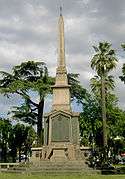 |
? (6.34 m) |
Dogali | Ramses II | Baths of Diocletian 41°54′7.8″N 12°29′50.9″E / 41.902167°N 12.497472°E |
Originally one of a pair from Heliopolis, the other now in the Boboli Gardens in Florence. Moved to the Temple of Isis in Rome. Found in 1883 by Rodolfo Lanciani near Santa Maria sopra Minerva. Now commemorates the Battle of Dogali, originally in front of Near Termini Station and moved to its present site in 1924. |
| |
2.68 m (12.23 m) |
Matteiano | Ramses II | Villa Celimontana 41°53′0.2″N 12°29′43.2″E / 41.883389°N 12.495333°E |
Originally one of a pair at the Temple of Ra in Heliopolis, the other being the Macuteo which retains much more of its original height. Moved to the Temple of Isis near Santa Maria sopra Minerva. Found in the 14th century and erected east of Santa Maria in Aracoeli on the Capitoline. Moved to Villa Celimontana after Michelangelo redesigned the square in the late 16th century. Lost again; fragments rediscovered and re-erected in 1820. Smallest obelisk in Rome. |
Ancient Roman obelisks
At least five obelisks were manufactured in Egypt in the Roman period at the request of the wealthy Romans, or made in Rome as copies of ancient Egyptian originals.
| Image | Height (with base) |
Name | Location | Notes |
|---|---|---|---|---|
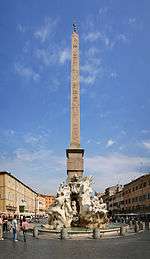 |
16.53 m (30+ m) |
Agonalis
(Pamphilius) |
Piazza Navona 41°53′56.3″N 12°28′23.1″E / 41.898972°N 12.473083°E |
A copy commissioned by Domitian and erected at the Temple of Serapis. Moved to the Circus of Maxentius by Maxentius. The Earl of Arundel paid a deposit and attempted to ship the four pieces to London in the late 1630s but Urban VIII disallowed its export.[6]
Erected on top of the Fontana dei Quattro Fiumi by Bernini in 1651. |
| |
14.63 m (28.94 m) |
Quirinale | Piazza del Quirinale 41°53′56.7″N 12°29′11.9″E / 41.899083°N 12.486639°E |
Originally erected on the eastern flank of the Mausoleum of Augustus, paired with the Esquiline obelisk. Found in 1527. Erected by Pope Pius VI in 1786 on the Quirinal Hill next to statues of the Dioscuri (called the 'Horse Tamers') from the Baths of Constantine. |
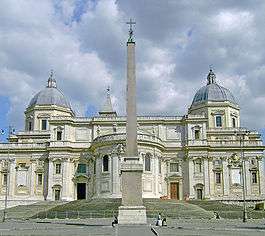 |
14.75 m (25.53 m) |
Esquiline | Piazza dell'Esquilino 41°53′53.4″N 12°29′51″E / 41.898167°N 12.49750°E |
Originally erected on the western flank of the Mausoleum of Augustus, paired with the Quirinale obelisk. Found in 1527 and erected in 1587 by Pope Sixtus V behind Santa Maria Maggiore. |
| |
13.91 m (30.45 m) |
Sallustiano | Trinità dei Monti 41°54′22.1″N 12°28′59.6″E / 41.906139°N 12.483222°E |
Above the Spanish Steps. An Aurelian copy, although smaller, of the Flaminio obelisk of Ramses II in the Piazza del Popolo, for the Gardens of Sallust. Found by the Ludovisi and moved to the Piazza di San Giovanni in Laterano in 1734, but kept horizontal. Erected in 1789 by Pope Pius VI. |
 |
9.24 m (17.26 m) |
Pinciano | Pincian Hill 41°54′38.9″N 12°28′47.1″E / 41.910806°N 12.479750°E |
Commissioned by Hadrian and erected in Tivoli for the tomb of Antinous. Moved to Rome by Elagabalus to decorate the spina of the Circus Varianus. Found in the 16th century near the Porta Maggiore. Moved to the Palazzo Barberini, then moved to the Vatican by Pope Clement XIV; finally erected on the Pincian by Pope Pius VII in 1822. |
Obelisk of Axum
There was also an Ethiopian obelisk in Rome, the Obelisk of Axum, 24 m, placed in the Piazza di Porta Capena. It had been taken from Axum by the Italian Army during the Italian occupation of Ethiopia in 1937. It was struck by lightning in May 2002. After being restored, it was disassembled and returned to Ethiopia in April 2005.
Modern obelisks
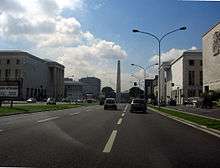
There are five well-known modern obelisks in Rome:
- Villa Medici, 19th century copy of the original, found in the gardens and taken to Florence.
- Two obelisks in the Villa Torlonia, 1842, Baveno granite
- Foro Italico, 1932, 17.5 m, Carrara marble, originally dedicated to Benito Mussolini, and inscribed Mussolini Dux
- Marconi, 1959, 45 m, in the centre of the EUR district, dedicated to Guglielmo Marconi, built for the 1960 Summer Olympics. 92 panels in white marble contain illustrations of Marconi's career and allegorical scenes.
Former locations of some obelisks
|
Further reading
- Wirsching, Armin (2000), "How the Obelisks Reached Rome: Evidence of Roman Double-Ships", The International Journal of Nautical Archaeology, 29 (2): 273–283, doi:10.1111/j.1095-9270.2000.tb01456.x
- Wirsching, Armin (2003), "Supplementary Remarks on the Roman Obelisk-Ships", The International Journal of Nautical Archaeology, 32 (1): 121–123, doi:10.1111/j.1095-9270.2003.tb01438.x
- Wirsching, Armin (2013), Obelisken transportieren und aufrichten in Aegypten und in Rom, ISBN 978-3-8334-8513-8 (3d ed.)
- D'Onofrio, Cesare (1967), Gli obelischi di Roma
See also
Monoliths
Roman triumphal monuments
External links
![]() Media related to Obelisks of Rome at Wikimedia Commons
Media related to Obelisks of Rome at Wikimedia Commons
- Obelisks in Rome (Andrea Pollett)
- Obelisks of Rome (series of articles in Platner's Topographical Dictionary of Ancient Rome)
- Obelischi di Roma
- Obelisk of Psametik II and Augustus, erected by Pope Pius VI in Piazza Montecitorio
- Romeartlover.it: Obeliks of Rome
Annotations
References
- ↑ http://www.pbs.org/wgbh/nova/egypt/raising/rome.html
- 1 2 http://www.ancient-wisdom.com/menhirs.htm
- ↑ Touring Club Italiano, Roma e Dintorni.
- 1 2 Travels and Adventures, Chapter 3, Pero Tafur, digitized from The Broadway Travellers series, edited by Sir E. Denison Ross and Eileen Power, translated and edited with an introduction by Malcolm Letts (New York, London: Harper & brothers 1926):
On the other side of it is a high tower made of one piece of stone, like a three-cornered diamond raised upon three brazen feet; and many, taking it for a holy thing, creep between the ground and the base of that tower. This was a work undertaken in honour of Julius Caesar and assigned for his burial, and on the top of it are three large gilt apples in which is the dust of the Emperor [sic] Julius Caesar, and certainly it is a noble edifice and marvellously ordered and very strange. It is called Caesar's needle, and in the middle and at the base, and even at the top, are a few ancient letters carved in the stone which now cannot well be read, but in fact they record that the body of Julius Caesar was buried there.
- ↑ Pedro Tafur's Andanças (1874 edition) referenced in the Diccionario crítico etimológico castellano e hispánico, Joan Corominas, José Antonio Pascual, 1987, Editorial Gredos, Tome I, ISBN 84-249-1361-2, entry carnicol, page 880.
- ↑ Edward Chaney, "Roma Britannica and the Cultural Memory of Egypt: Lord Arundel and the Obelisk of Domitian", in Roma Britannica: Art Patronage and Cultural Exchange in Eighteenth-Century Rome, eds. D. Marshall, K. Wolfe and S. Russell, British School at Rome, 2011, pp. 147-70.